TWC'S Odyssey
HEART
OF THE
SILK ROAD
Tan Wee Cheng's Travels
in the Central Asian Republics of Kazakstan, Kyrgyzstan, Uzbekistan and
Tajikistan
 |
KAZAKSTAN
6 Jul Almaty |
We arrived at Almaty International Airport at 5 am on Turkish Airlines.
Trouble started immediately - Robert's luggage did not arrive. Not
a good omen. We spent an hour trying to sort things out, certainly
not helped by our inability to speak Russian or Kazak (though after one
hundred years of Russian & Soviet rule, many Kazaks in Almaty do not
speak Kazak well). Next we had to deal with the taxi drivers - most
of them wanted US$40 for the trip to the city central. No way, as
my Almaty friend told me it shouldn't be more than US$10. We stood
by that figure and sure enough, a driver broke ranks and agreed to US$10.
Thereupon, our driver sped towards central Almaty at an average speed
of 110 km/h. Not very assuring when you know that he's seriously
short-sighted, apparent from the way he examined at the address slip we
passed him. Alarmed, I tried to put on the seat-belt, only to be
told by him "Nyet problem". We then checked into Daulet Hotel, a
pretty run-down place, but acceptable for the price of US$30 for a double
room. The staff's friendly but none could speak English.
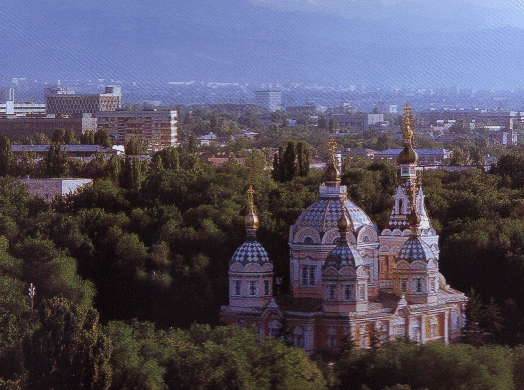
|
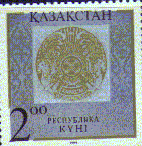 |
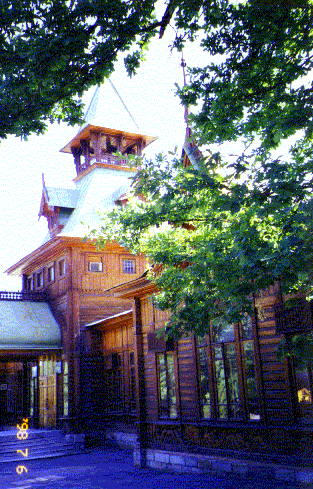
|
| Zenkov Cathedral in Panfilov Park (postcard) : Built
without a single nail. Only reopened again a few years ago.
Under slow renovation. But will it survive the migration of its believers? |
Kazak stamp showing the coat of arms of the Republic
of Kazakstan. |
Colonial Russian houses
in the city central. |
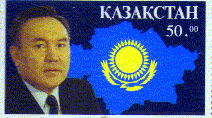 |
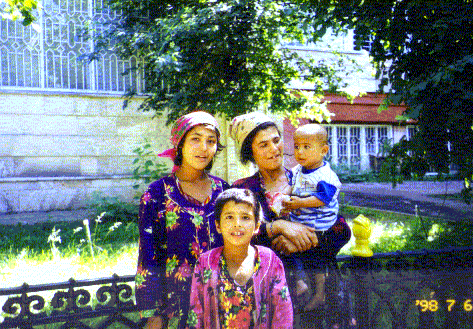 |
 |
| Kazak stamp showing President Nazarbayev |
Family outing:
These may be ethnic Uzbeks or Tajiks from the southern
part of the country. |
Flag of the old Kazak Soviet
Socialist Republic (KzSSR) |
Almaty is a city of low-rises. Most buildings are hardly higher than
5 storeys. City planners have decided that it was too dangerous to
build high rises in a city that was twice-flattened by earthquakes in recent
times - in 1887 and 1911. But I did not expect to see overgrown weeds
and the numerous potholes in the centre of Kazakstan's commercial capital.
I have read so much about the mega-deals signed in the country's oil and
gas sector, and had expected shiny glass towers and tidy streets.
Perhaps, most of the funds have been moved to the new capital, Astana,
that godforsaken place in the northern steppes bordering Russian Siberia
(I was told that some ministers' wives threatened their husbands with
divorce if they want the whole family to move to Astana). Another
thing: Almaty looked like a huge city with few people - the streets are
wide but comparatively few cars for a city of this size (1 million people)
and certainly no traffic jams.
A redeeming feature, however, is the greenery so prevalent in this city,
as well as the fast-flowing streams along the city's streets and the towering
snowcapped Zailiysky Alatau mountains to the south. Another interesting
thing about Almaty is the multiracial population of the city - we saw not
only the Mongol/Chinese-like Kazaks, but also Russians (or other European
peoples) and some Iranian looking people (probably Tajiks) on the streets.
Indeed Kazaks say that there are more than 100 ethnic groups (or "nationalities",
in ex-USSR terminology) in Almaty. As an Asian, it is certainly amazing
to see people who look like Asians in a city with Cyrillic signboards everywhere.
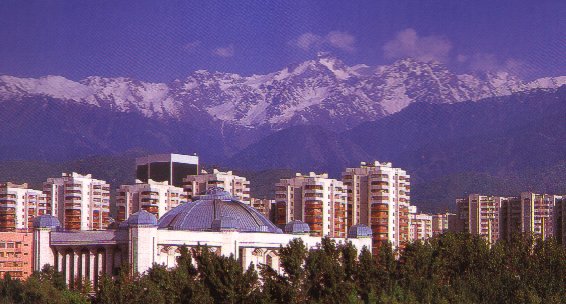 |
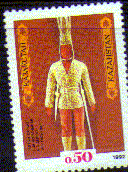 |
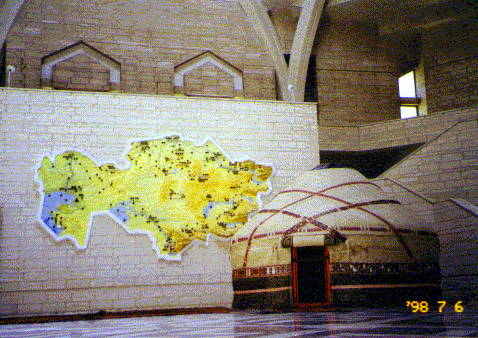
|
|
Central State Museum (postcard): Unfortunately,
the Golden Warrior is now in Astana.
|
Kazak stamp showing the Golden Warrior, an ancient
Scythian archaeological find.
|
Dreams of an earlier age:
A traditional yurt in the Central State Museum
|
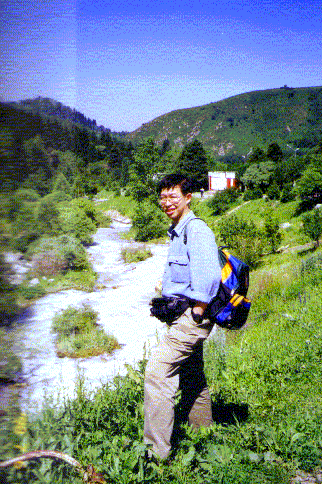
|

|
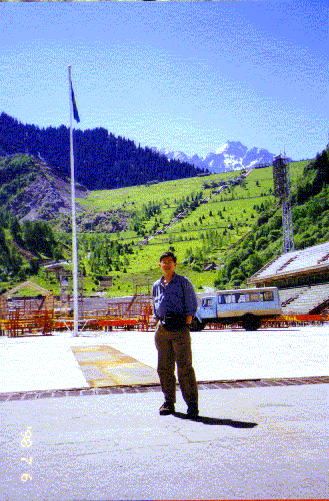
|
|
On the mountains:
Outside the Medeu Rink
|
One of the first Kazak stamps (overprint on USSR
stamps) showing the Soviet Space project. Russian rockets are still
being launched from Kazak soil.
|
Medeu Rink
|
During the day, we visited the main attractions of Almaty - Panfilov (or
Heroes') Park & Zenkov Cathedral in the middle, War Memorial, Central
Market, Central State Museum (pity that the famous Golden Warrior had been
moved to Astana) and the Respublika alangy - the huge square in front of
the presidential palace which was a typical Stalinist designer piece.
We also visited the Medeu Skating Rink - the largest in the world.
No big deal, I thought, perhaps because I had expected it to be much larger.
In the evening, we met Blair, who works at PWC Almaty, and she brought
us to a fancy Georgian restaurant in the suburbs. A wonderful meal
topped with good Georgian wine.
Click to here to go to next page: Karkara
Valley

